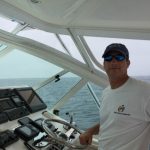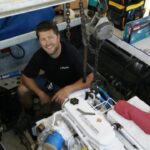Cummins Marine Diesel Repower Specialists › Forums › Marine Transmissions › Trans oil press
- This topic has 9 replies, 3 voices, and was last updated 6 years ago by
 Tony Athens.
Tony Athens.
-
CreatorTopic
-
May 30, 2017 at 10:45 am #19239

PhilipParticipantVessel Name: 2007 35’ Cabo ‘FUGA’
Engines: Cummins QSC8.3-540’s
Location: Long Beach, CA
In the below picture, is the port which I would use for oil pressure monitoring during trolling valve operation circled in red correct?
I assume I am looking to monitor the oil pressure to the clutch plates?
And if this is the correct port is it a 1/8 NPT or some other thread?
What would be the operating max pressure I would see and what rating hose should I use? -
CreatorTopic
-
AuthorReplies
-
June 5, 2017 at 7:18 pm #19547

Tony AthensModeratorVessel Name: Local Banks
Engines: QSB 6.7 550 HP
Location: Oxnard, CA
Country: USA
You are literally “spinning your wheels” blind unless you have one or both of thise things at you helm to monitor accurately..
Clutch pressure
Shaft RPM
Throttle position will tell you NOTHING..
Tony
June 4, 2017 at 11:12 pm #19488
PhilipParticipantVessel Name: 2007 35’ Cabo ‘FUGA’
Engines: Cummins QSC8.3-540’s
Location: Long Beach, CA
Tony,
Because I get vastly different shaft RPM’s in trolling mode with the throttle position matched the boat is difficult to steer in trolling mode. When I say vastly, when engaging the trolling mode (depress troll button and shift into FWD) and with the the throttles matched, the starboard shaft doesn’t spin at all when the port shaft is making revolutions. Not until I move the starboard throttle maybe an additional 2 inches does the starboard shaft begin to rotate.While I understand that external forces (tide, current, etc) as well as differences in shaft, strut, log, etc can affect the RPM’s slightly I don’t think it should be quite so different, or should it?
If this doesn’t sound correct I figure my next step is to match pressure and check shaft rpm and throttle position differences. Or I can match throttle position and compare pressures and RPM’s.
I know it’s a complex system just trying to figure out if I trace out transmission issues or electrical issues.
If all this makes sense can you advise if what my concern/issue is valid and if this is a correct trouble shooting sequence.
June 3, 2017 at 4:41 pm #19464
Tony AthensModeratorVessel Name: Local Banks
Engines: QSB 6.7 550 HP
Location: Oxnard, CA
Country: USA
Phillip,
Exactly what are you trying to accomplish? If you are trying to monitor clutch pressure, then you need a accurate 0-400 PSI gauge in a place where you can SEE it.. The sender or hose needs to be attached to the port you circled..
Tony
June 3, 2017 at 1:55 pm #19460
PhilipParticipantVessel Name: 2007 35’ Cabo ‘FUGA’
Engines: Cummins QSC8.3-540’s
Location: Long Beach, CA
Can I just screw a guage into the port or should I use a length of hydraulic hose as well?
May 30, 2017 at 4:30 pm #19272
Corey SchmidtForum ModeratorVessel Name: Rebel Belle
Engines: Cummins
Location: Oxnard, CA
Country: USA
Pressure indication…
I will yield the best response to Tony as his experience with this stuff is much more vast but my gut says yes on the pressure monitoring… let’s confirm that the valves are producing similar pressures before going much further… a couple of senders and gauges will tell the story. The culprit could be many things at this point… valves, coils, control system… until we SEE the pressures, we won’t be able to do much more.
May 30, 2017 at 4:02 pm #19262
PhilipParticipantVessel Name: 2007 35’ Cabo ‘FUGA’
Engines: Cummins QSC8.3-540’s
Location: Long Beach, CA
Correct on the EEC-3 and yes that is what I’m asking/trying to sort out.
I have to push on throttle probably 2-3″ more than the other to match shaft rpm.
Engines are recently aligned, new cutlass bearings, shafts were checked straight, props were computer matched via propscan.
If it were just a little off I would understand external forces etc. but it’s squirmy cause you can never really match the shaft rams so I wondering if all is healthy.When I bought the boat in Jan 16 the trolling valves were troublesome during sea trial and subsequently removed and cleaned prior to sale to get them working correctly. The trolling valves when cleaned had some very fine dust like sediment when cleaned according to the mechanic.
I’m wondering if I don’t have some residual “gunk” in a trolling valve itself causing the difference and thus was figuring the next step was to confirm the pressures.
Shouldn’t the throttles be kinda close during operation especially at the dock during testing??
Thoughts?
May 30, 2017 at 3:05 pm #19256
Corey SchmidtForum ModeratorVessel Name: Rebel Belle
Engines: Cummins
Location: Oxnard, CA
Country: USA
Philip, I’m assuming you have a Glendinning EEC3 fly-by-wire control system?
If I understand what you’re asking correctly, you’re wanting to know why your SHAFT RPMs are different even though your throttle input and engine RPMs are the same? If that’s the question, then the answer is that the external forces that load the propeller are VARYING… things like current, slippage, and temperature, etc. can cause fluctuations on the shaft RPM when trolling….
May 30, 2017 at 1:42 pm #19249
PhilipParticipantVessel Name: 2007 35’ Cabo ‘FUGA’
Engines: Cummins QSC8.3-540’s
Location: Long Beach, CA
Thanks Cory!
The current oil lines are the standard Cummins supplied ones.
I’m trying to decode why I’m getting different shaft rotation RPM with the same throttle position during trolling mode ops.
QSC8.3-540’s with ZF285A’s and Glenndining controls.I pulled all 3 solenoid (fwd, rev, troll) and cleaned them real good with brake cleaner which didn’t change anything.
May 30, 2017 at 11:26 am #19245
Corey SchmidtForum ModeratorVessel Name: Rebel Belle
Engines: Cummins
Location: Oxnard, CA
Country: USA
Yes, that is the correct working oil pressure port and it is a 1/8″ NPT thread. That gear will operate somewhere around 400 PSI working pressure and you’ll want oil lines rated to around 4-5 times that working pressure… SAE R1 hose is rated to around 2000 PSI… not sure which oil lines you have on the gear currently?
-
AuthorReplies
You must be logged in to reply to this topic.
